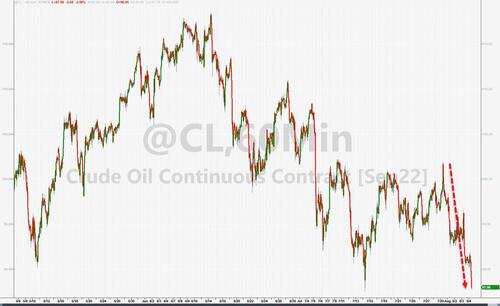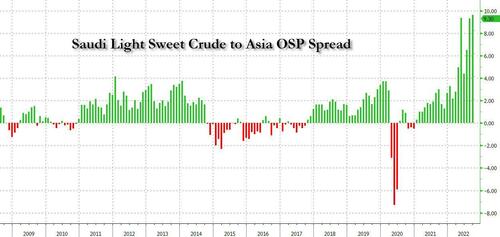
The oil market's Jekyll and Hyde moment is getting scarier by the day.
On one hand, fears of an imminent recession (validated not just by the US 2s10s curve hitting -39bps this morning but the BOE now forecasting a 5-quarter recession starting in Q4) are sending oil prices tumbling, with WTI tumbling below $90 for the first time since the start of the war in Ukraine.
On the other hand, the chaos in the physical market - the one that actually matters to commodities which trade not based on some future point in the curve but on the harsh reality of the spot "here and now" - is getting worse by the day, and today Saudi Arabia once again raised oil prices for buyers in Asia into record territory, as contrary to what price say, the global physical market remaining extremely tight despite alleged signs of weakening demand as economies slow (contrary to the always wrong conventional wisdom, Bank of America last week wrote that "The Fall Of Gasoline Demand Has Been Grossly Exaggerated.")
As shown in the chart below, Saudi oil giant, Aramco, hiked its Arab Light grade for next month’s shipments to Asia to $9.80/bbl above the regional benchmark. That’s a jump of 50 cents from August, and a new all time high.
Below are some more thoughts from early July by Bloomberg's Jake Lloyd-Smith on just this mismatch between physical and paper oil, where the gap is starting to approximate that of gold.
The global oil market is having a Jekyll-and-Hyde moment. A mismatch has opened up between what’s happening in crude futures, which have sold off on fears of a slowdown, and the physical side, which still looks pretty solid. That means if macro concerns start to lose their vigor, there’s support for a rebound.
In Robert Louis Stevenson’s classic 19th century novella, Hyde’s the rogue while Jekyll’s the good guy. The twist, of course, is they are one and the same person. In oil, futures have been dragged lower by fears a recession may erode demand; they’ve gone all Hyde. But in the real world, there’s still plenty of competition for prompt barrels showcasing the commodity’s Jekyll.
This dissonance caught the attention of the folk at RBC.
“The financial oil market is dislocating dramatically from an extremely tight spot physical market,” analysts including Helima Croft and Michael Tran said in a note.
“The physical market is pricing in scarcity, while the financial market is pricing in recession.”
That can make for some confusing signals.
On the one hand, oil kingpin Saudi Arabia just increased next month’s prices for Asia amid signs that underlying demand remains robust, but on the other hand, futures have been in retreat.
And while Brent is on course for a substantial weekly decline, the global benchmark’s prompt spread - that’s the difference between its two nearest contracts - remains firmly backwardated, a bullish pattern.
The oil market’s Jekyll and Hyde moment is getting scarier by the day.
On one hand, fears of an imminent recession (validated not just by the US 2s10s curve hitting -39bps this morning but the BOE now forecasting a 5-quarter recession starting in Q4) are sending oil prices tumbling, with WTI tumbling below $90 for the first time since the start of the war in Ukraine.
On the other hand, the chaos in the physical market – the one that actually matters to commodities which trade not based on some future point in the curve but on the harsh reality of the spot “here and now” – is getting worse by the day, and today Saudi Arabia once again raised oil prices for buyers in Asia into record territory, as contrary to what price say, the global physical market remaining extremely tight despite alleged signs of weakening demand as economies slow (contrary to the always wrong conventional wisdom, Bank of America last week wrote that “The Fall Of Gasoline Demand Has Been Grossly Exaggerated.”)
As shown in the chart below, Saudi oil giant, Aramco, hiked its Arab Light grade for next month’s shipments to Asia to $9.80/bbl above the regional benchmark. That’s a jump of 50 cents from August, and a new all time high.
Below are some more thoughts from early July by Bloomberg’s Jake Lloyd-Smith on just this mismatch between physical and paper oil, where the gap is starting to approximate that of gold.
The global oil market is having a Jekyll-and-Hyde moment. A mismatch has opened up between what’s happening in crude futures, which have sold off on fears of a slowdown, and the physical side, which still looks pretty solid. That means if macro concerns start to lose their vigor, there’s support for a rebound.
In Robert Louis Stevenson’s classic 19th century novella, Hyde’s the rogue while Jekyll’s the good guy. The twist, of course, is they are one and the same person. In oil, futures have been dragged lower by fears a recession may erode demand; they’ve gone all Hyde. But in the real world, there’s still plenty of competition for prompt barrels showcasing the commodity’s Jekyll.
This dissonance caught the attention of the folk at RBC.
“The financial oil market is dislocating dramatically from an extremely tight spot physical market,” analysts including Helima Croft and Michael Tran said in a note.
“The physical market is pricing in scarcity, while the financial market is pricing in recession.”
That can make for some confusing signals.
On the one hand, oil kingpin Saudi Arabia just increased next month’s prices for Asia amid signs that underlying demand remains robust, but on the other hand, futures have been in retreat.
And while Brent is on course for a substantial weekly decline, the global benchmark’s prompt spread – that’s the difference between its two nearest contracts – remains firmly backwardated, a bullish pattern.






